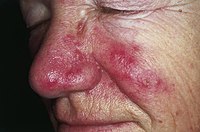
Photo from wikipedia
1https://www.medicaljournals.se/acta/content/abstract/10.2340/00015555-3167 Rosacea is a chronic inflammatory disease with a prevalence varying between 1 and 20% and is the highest in fair-skinned Europeans (1). The appearance of rosacea differs between the… Click to show full abstract
1https://www.medicaljournals.se/acta/content/abstract/10.2340/00015555-3167 Rosacea is a chronic inflammatory disease with a prevalence varying between 1 and 20% and is the highest in fair-skinned Europeans (1). The appearance of rosacea differs between the sexes; there is a female predominance and the onset of the disease is earlier in females than in males (1). Of the 4 subtypes of rosacea (erythematoteleangiectatic, papulopustular, ocular and phymatotic) the erythematoteleangiectatic type is more common in females and the phymatous type in males (2). There is a rising consensus that rosacea is not only limited to the skin but is a chronic systemic inflammatory disease. Several systemic diseases have recently been shown to be associated with rosacea (3). However, it is disputed whether rosacea is associated with cardiovascular (CV) diseases. The risk for comorbidities in rosacea has also been suggested to differ between sexes. Egeberg et al. found that rosacea is associated with type 1 diabetes, celiac disease, multiple sclerosis and rheumatoid arthritis particularly in females (4). The aim of this study was to clarify the CV risk factors in rosacea patients by comprehensively studying the CV risk profile of middle-aged patients with rosacea.
Journal Title: Acta dermato-venereologica
Year Published: 2019
Link to full text (if available)
Share on Social Media: Sign Up to like & get
recommendations!